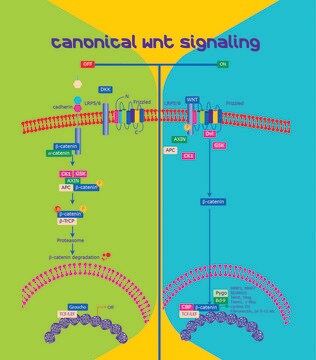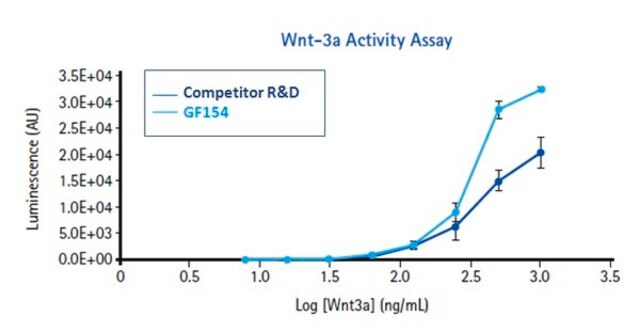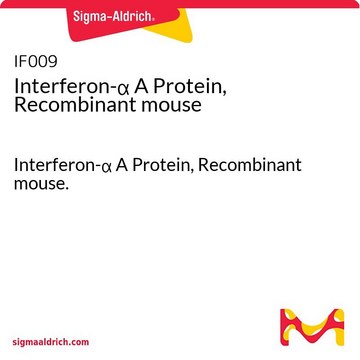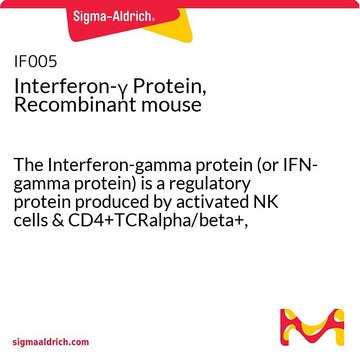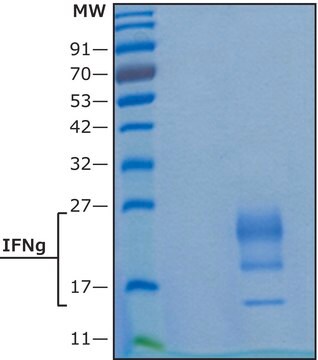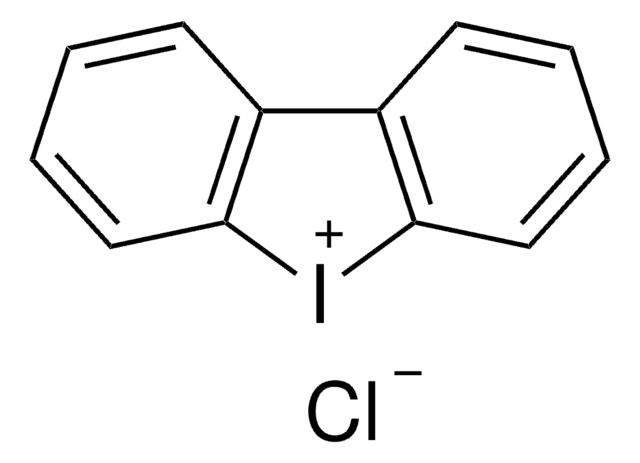GF146
Wnt-5a Protein, Recombinant mouse
The Wnt5a protein is a 352 amino acid protein containing 23 conserved cysteines & contains a cysteine modified by palmitate which is essential for receptor binding & biological activity.
About This Item
Productos recomendados
Descripción general
Wnt ligands bind to cell surface co-receptors consisting of a Frizzled protein and lipoprotein receptor related protein (5/6). Wnt 5a belongs to the non-canonical class of Wnt proteins which are independent of or inhibit β-catenin signalling. Wnt5a when bound to its receptor triggers an intracellular Ca release which activates PKC and CaMK11 which in turn activates TAK1 MAPkinase-kinase and nemo-like(NLK) kinase. NLK phosphorylates Lef1/TCF protein complex inhibiting the formation of the β-catenin Lef1/TCF DNA complex. In contrast Wnt3a signalling stabilizes β-catenin increasing the formation of the β-catenin Lef1/TCF DNA complex.
Wnt signalling has been implicated in the control of differentiation of stem cells. The Wnts have also been shown to have putative roles in the regulation of adult stem cells. Recently injection of embryonic stem cells into hearts has been shown to correct cardiac defects. This occurs through the secretion of factors from stem cells which correct gene defects in neighbouring cells. Wnt5a, a short term factor secreted by the stem cells, has been shown to be critical for this process (Fraidenraich and Benzra, 2006).
Aplicación
• When using this protein, if possible, dose it directly onto cells at the required dilution without pre-filtering.
• The toxicity of the Chaps in the storage buffer should be tested empirically on the cell line prior to using the Wnt5a protein.
• Generally, we suggest that a minimum dilution of Wnt5a of 1:1000 on mammalian cells results in a final concentration of Chaps that is not toxic to the cells.
• If dosing on cells over a period of days/weeks, it is recommended that media containing Wnt5a is replenished daily, rather than dosing Wnt5a to existing media daily. This is because accumulation of Chaps is undesirable for cell viability.
Envase
Forma física
Almacenamiento y estabilidad
Nota de análisis
Información legal
Cláusula de descargo de responsabilidad
Código de clase de almacenamiento
13 - Non Combustible Solids
Clase de riesgo para el agua (WGK)
WGK 2
Punto de inflamabilidad (°F)
Not applicable
Punto de inflamabilidad (°C)
Not applicable
Certificados de análisis (COA)
Busque Certificados de análisis (COA) introduciendo el número de lote del producto. Los números de lote se encuentran en la etiqueta del producto después de las palabras «Lot» o «Batch»
¿Ya tiene este producto?
Encuentre la documentación para los productos que ha comprado recientemente en la Biblioteca de documentos.
Artículos
Role of growth factors in stem cell differentiation and various growth factors for your research at sigmaaldrich.com
Contenido relacionado
This article shows that a PES membrane containing Stericup Quick Release filter provides an alternative for the pluripotent expansion of embryonic stem cells.
Nuestro equipo de científicos tiene experiencia en todas las áreas de investigación: Ciencias de la vida, Ciencia de los materiales, Síntesis química, Cromatografía, Analítica y muchas otras.
Póngase en contacto con el Servicio técnico